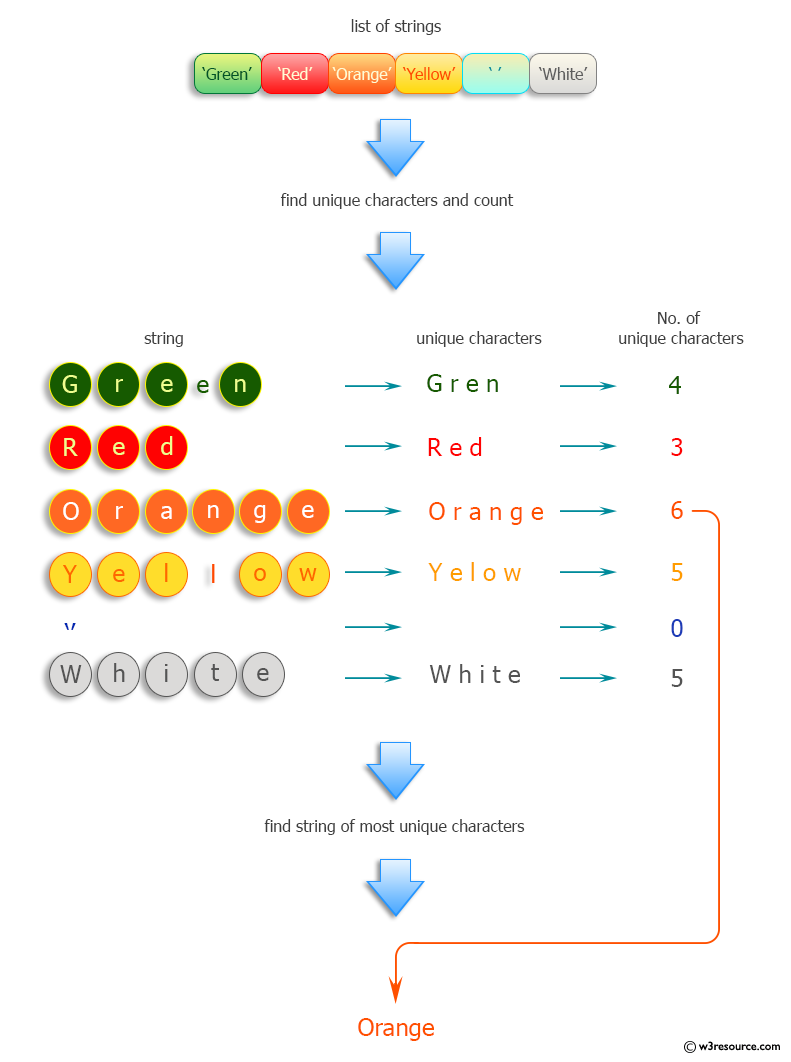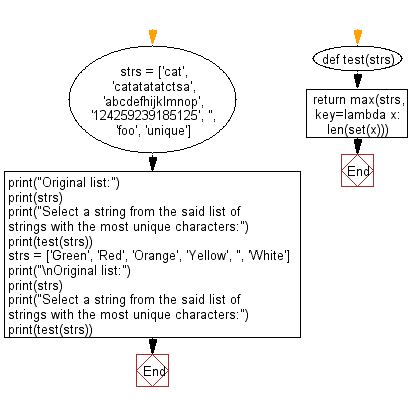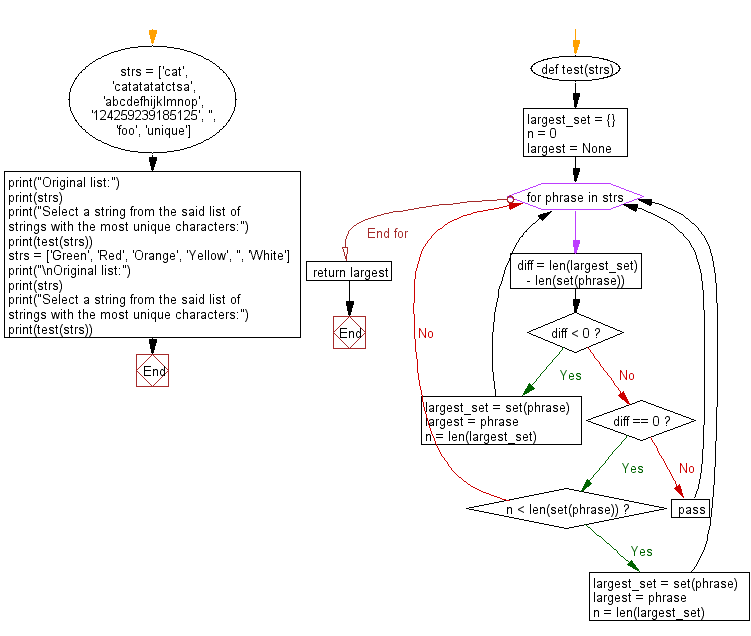Python: Select a string from a given list of strings with the most unique characters
Python Programming Puzzles: Exercise-28 with Solution
Write a Python program to select a string from a given list of strings with the most unique characters.
Input: ['cat', 'catatatatctsa', 'abcdefhijklmnop', '124259239185125', '', 'foo', 'unique'] Output: abcdefhijklmnop Input: ['Green', 'Red', 'Orange', 'Yellow', '', 'White'] Output: Orange
Pictorial Presentation:

Sample Solution-1:
Python Code:
#License: https://bit.ly/3oLErEI
def test(strs):
return max(strs, key=lambda x: len(set(x)))
strs = ['cat', 'catatatatctsa', 'abcdefhijklmnop', '124259239185125', '', 'foo', 'unique']
print("Original list:")
print(strs)
print("Select a string from the said list of strings with the most unique characters:")
print(test(strs))
strs = ['Green', 'Red', 'Orange', 'Yellow', '', 'White']
print("\nOriginal list:")
print(strs)
print("Select a string from the said list of strings with the most unique characters:")
print(test(strs))
Sample Output:
Original list: ['cat', 'catatatatctsa', 'abcdefhijklmnop', '124259239185125', '', 'foo', 'unique'] Select a string from the said list of strings with the most unique characters: abcdefhijklmnop Original list: ['Green', 'Red', 'Orange', 'Yellow', '', 'White'] Select a string from the said list of strings with the most unique characters: Orange
Flowchart:

Visualize Python code execution:
The following tool visualize what the computer is doing step-by-step as it executes the said program:
Sample Solution-2:
Python Code:
#License: https://bit.ly/3oLErEI
def test(strs):
largest_set = {}
n = 0
largest = None
for phrase in strs:
diff = len(largest_set) - len(set(phrase))
if diff < 0:
largest_set = set(phrase)
largest = phrase
n = len(largest_set)
elif diff == 0:
if n < len(set(phrase)):
largest_set = set(phrase)
largest = phrase
n = len(largest_set)
else:
pass
return largest
strs = ['cat', 'catatatatctsa', 'abcdefhijklmnop', '124259239185125', '', 'foo', 'unique']
print("Original list:")
print(strs)
print("Select a string from the said list of strings with the most unique characters:")
print(test(strs))
strs = ['Green', 'Red', 'Orange', 'Yellow', '', 'White']
print("\nOriginal list:")
print(strs)
print("Select a string from the said list of strings with the most unique characters:")
print(test(strs))
Sample Output:
Original list: ['cat', 'catatatatctsa', 'abcdefhijklmnop', '124259239185125', '', 'foo', 'unique'] Select a string from the said list of strings with the most unique characters: abcdefhijklmnop Original list: ['Green', 'Red', 'Orange', 'Yellow', '', 'White'] Select a string from the said list of strings with the most unique characters: Orange
Flowchart:

Visualize Python code execution:
The following tool visualize what the computer is doing step-by-step as it executes the said program:
Python Code Editor :
Have another way to solve this solution? Contribute your code (and comments) through Disqus.
Previous: Find x that minimizes mean squared deviation from a given list of numbers.
Next: Find the indices of two numbers that sum to 0 in a given list.
What is the difficulty level of this exercise?
Test your Programming skills with w3resource's quiz.
Python: Tips of the Day
Find current directory and file's directory:
To get the full path to the directory a Python file is contained in, write this in that file:
import os dir_path = os.path.dirname(os.path.realpath(__file__))
(Note that the incantation above won't work if you've already used os.chdir() to change your current working directory, since the value of the __file__ constant is relative to the current working directory and is not changed by an os.chdir() call.)
To get the current working directory use
import os cwd = os.getcwd()
Documentation references for the modules, constants and functions used above:
- The os and os.path modules.
- The __file__ constant
- os.path.realpath(path) (returns "the canonical path of the specified filename, eliminating any symbolic links encountered in the path")
- os.path.dirname(path) (returns "the directory name of pathname path")
- os.getcwd() (returns "a string representing the current working directory")
- os.chdir(path) ("change the current working directory to path")
Ref: https://bit.ly/3fy0R6m
- New Content published on w3resource:
- HTML-CSS Practical: Exercises, Practice, Solution
- Java Regular Expression: Exercises, Practice, Solution
- Scala Programming Exercises, Practice, Solution
- Python Itertools exercises
- Python Numpy exercises
- Python GeoPy Package exercises
- Python Pandas exercises
- Python nltk exercises
- Python BeautifulSoup exercises
- Form Template
- Composer - PHP Package Manager
- PHPUnit - PHP Testing
- Laravel - PHP Framework
- Angular - JavaScript Framework
- Vue - JavaScript Framework
- Jest - JavaScript Testing Framework
